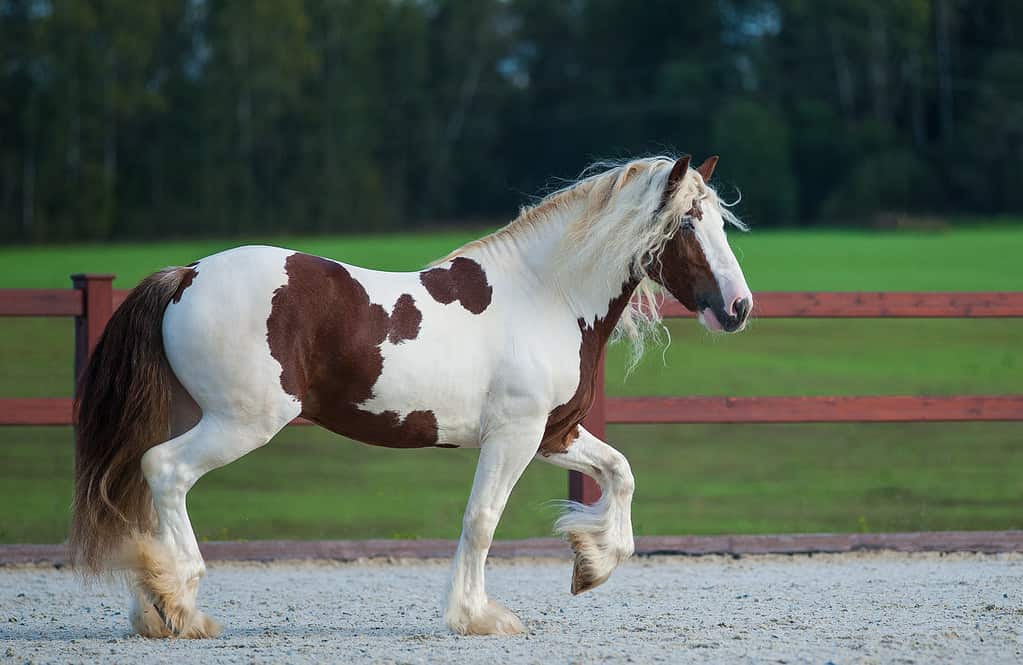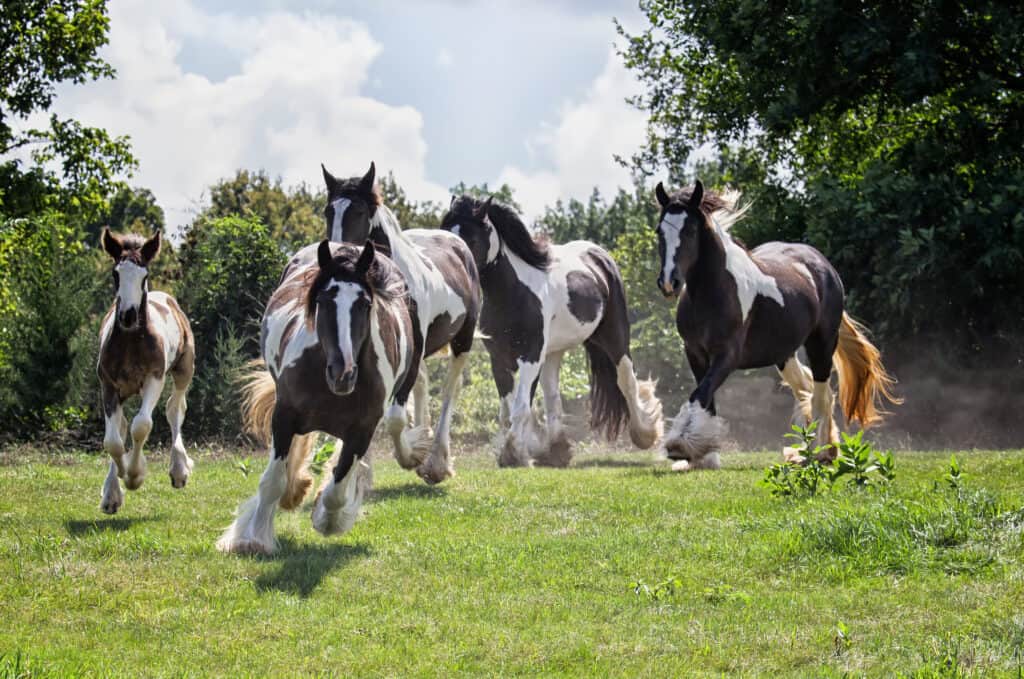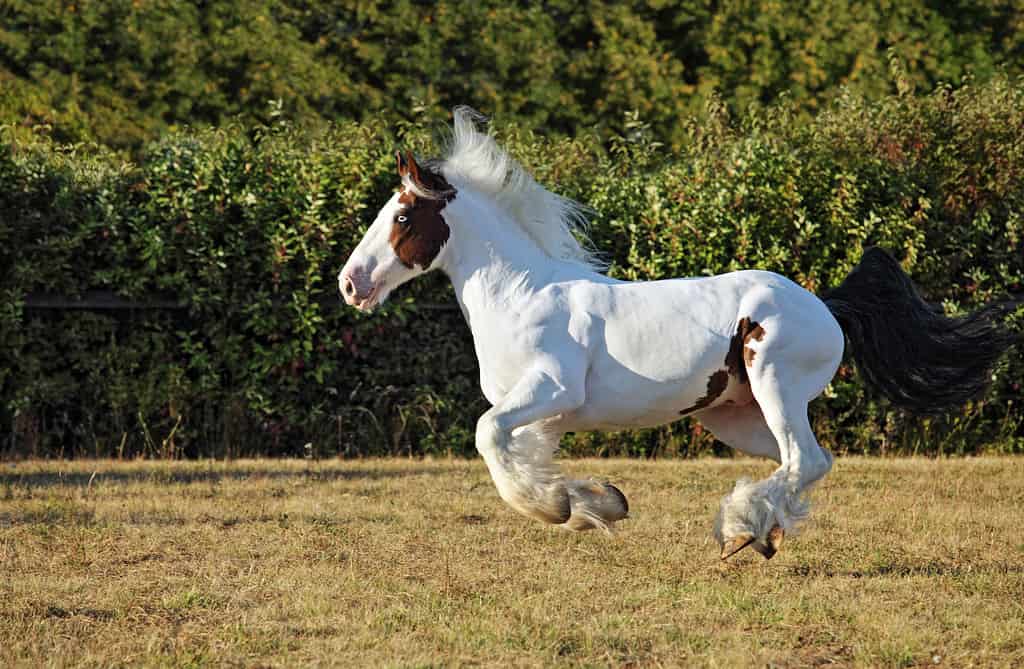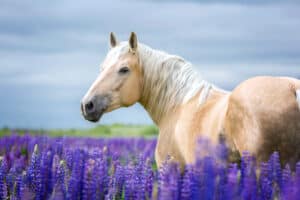Gypsy Vanners are widely sought-after horses because of their striking appearance and sweet disposition. It’s no wonder then that, of the roughly 10,000 that exist today, you want one to call your own. But horses aren’t just pretty pets… they’re a lot of work, time, and money. Let’s consider the costs of buying a Gypsy Vanner plus some common characteristics of the breed before you say “yes” to your dream horse.
Are Gypsy Vanners and Clydesdales the Same?

Draft horses aren’t all the same, even if they do look similar.
©mari_art/iStock via Getty Images
Gypsy Vanners and Clydesdales are two different breeds of horses. Both are purebred drafts but they differ in genetics, coloring, personality, and other characteristics.
However, the Drum Horse is a cross between a Gypsy Vanner and a Shire or Clydesdale. This is not a purebred breed, but it is becoming more popular in the United States.
Get to Know Gypsy Vanners: Breed Guide

The best way to describe a Gypsy Vanner? Gentle giants.
©critterbiz/Shutterstock.com
Like most draft breeds, Gypsy Vanners are gentle giants. Their size may seem imposing, but there’s a lot to love about this beautiful breed.
Physical Characteristics
When you think of a Gypsy Vanner, you are probably picturing a black and white Piebald. However, they can be any color as long as they meet the breed standards.
The breed standards that all purebred Gypsy Vanners must exhibit include:
- Short back
- Broad chest
- Heavy, well-rounded hips
- Heavy flat bone with ample hooves
- Feathering at the knees and hocks that cover the front of the hooves with an abundant mane and tail
- Sweet, refined head and strong neck
- Intelligent, kind, and docile
On average, a Gypsy Vanner stands between 13.2 and 15.2 hands high. The breed used to be taller but, over time, they were bred to be shorter and more compact drafts.
Personality Traits
As a breed, Gypsy Vanners are incredibly docile and even-tempered. Easy to train, athletic, and intelligent, these horses used to compete in a variety of equestrian disciplines. Even children can ride them, which makes them excellent family or therapy equines.
Gypsy Vanners 2024 Price Guide

A purebred horse of this breed can cost you upwards of $50,000!
©kondakov/iStock via Getty Images
What’s the cost of buying and owning a Gypsy Vanner? It depends on a variety of factors, but location is a big one. This breed is rare in North America, so it will cost you if you want to import a purebred Gypsy Vanner. Plus, they can get costly to feed or board due to their size and weight.
The Purchase Cost of Gypsy Vanners
The initial purchase cost of a Gypsy Vanner ranges drastically depending on whether it’s a mare, gelding, or stallion and whether it’s a purebred or cross.
You can expect to pay between $7,000 and $50,000 for a purebred Gypsy Vanner horse. The higher end of this range is typically reserved for stallions that can be used for stud, champions in the show ring, or a horse with exceptional bloodlines. Overall, this breed is often priced in the 5-figure range due to its incredible disposition and striking appearance.
Ongoing Costs of Owning a Gypsy Vanner
Now that you know the average purchase price of a Gypsy Vanner, let’s discuss the monthly and yearly cost of ownership.
Board
Boarding your Gypsy Vanner at a nearby farm will cost more than if you keep them at home. But if you don’t own a farm, expect to pay over $500 per month for them to stay at a facility.
This price depends entirely on location, the type of housing, and the level of care your horse receives. For example, a full-care stall-boarded horse will cost more than a self-care field-boarded horse.
Feed
Horses eat 2% of their body weight in forage a day and Gypsy Vanners average around 1,400 pounds. It will cost you roughly $200 per month for basic feed, not including supplements.
Vet and Farrier Care
Like many draft horses, Gypsy Vanners are prone to specific health conditions such as:
- Polysaccharide storage myopathy (PSSM)
- Scratches
- Malleanders and sallenders
- Chronic progressive lymphedema (CPL)
But like any other breed, they require routine vet and farrier care to keep them fit and healthy. An annual vet visit and a hoof trim every 6-8 weeks will run you about $1,000 a year. Plan to spend a bit extra if your Gypsy Vanner needs horseshoes.
Training and Showing
Training for your equine and lessons for you are an unexpected cost of horse ownership. If you want to compete, that’s another cost to consider!
The price of a good horse trainer depends on your location, the level of training needed, and their experience. Training costs can range from a few hundred dollars to a few thousand just for your horse. If you need lessons as well, expect to fork over at least $45 per ride.
Equipment and Supplies
One of the final things to consider about horse ownership, especially owning a Gypsy Vanner, is equipment and supply costs.
At a minimum, the basics you need for your horse include:
- Brushes
- Hoof picks
- Halters
- Lead ropes
- Blankets
- Bridles
- Saddles
- Bits
- Reins
And that’s not all! If you want to ride, you need jodhpurs, riding boots, a helmet, and gloves. While the benefit of this breed is that they’re great to ride, they’re even better to drive! Of course, that comes at a price — carts, harnesses, and other special equipment can add up quickly.
Are Gypsy Vanners Good Horses to Ride?

The epitome of a family pet, Gypsy Vanners are safe for both children and adults to ride.
©jacquec/iStock via Getty Images
Gypsy Vanners are excellent riding partners! This breed is a great horse to ride because it’s highly intelligent, engaged, and willing.
These characteristics help them excel in a plethora of equestrian disciplines such as trail riding, barrel racing, Western pleasure, dressage, and show jumping. Pocket-sized yet powerful, these traits are also what makes it a wonderful driving horse — it’s called a Gypsy “Vanner” because it’s bred to pull horse-drawn vans or carriages. The Gypsy Vanner can do it all!
Now that you know more about the breed and the cost of ownership, there’s only one question to ask: Is a Gypsy Vanner the right horse for you?
The photo featured at the top of this post is © Zuzule/iStock via Getty Images
Thank you for reading! Have some feedback for us? Contact the AZ Animals editorial team.






